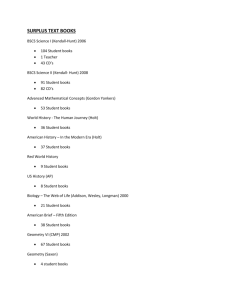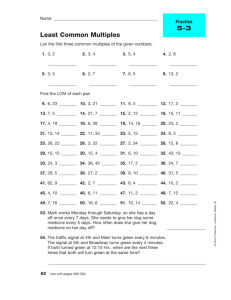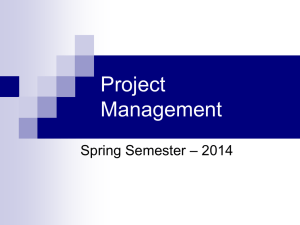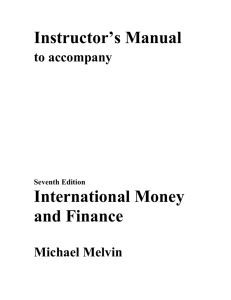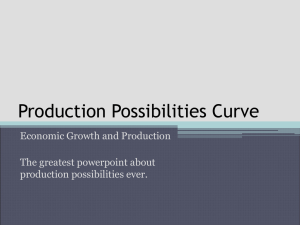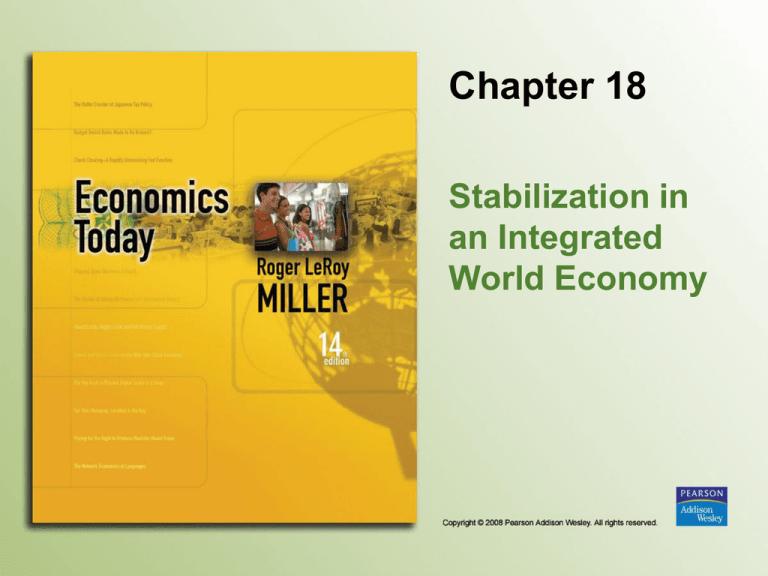
Chapter 18
Stabilization in
an Integrated
World Economy
Introduction
The period since 1984 is known as the
“Great Moderation.”
The variability of U.S. real GDP has been
more than 50% lower than was true from
1952 though 1983.
Can policymakers really contribute to
greater macroeconomic stability?
Copyright © 2008 Pearson Addison Wesley. All rights reserved.
18-2
Learning Objectives
• Explain why the actual unemployment
rate might depart from the natural rate
of unemployment
• Describe why economic theory implies that
there may be an inverse relationship between
the inflation rate and the unemployment rate,
reflected by the Phillips curve
• Evaluate how expectations affect the actual
relationship between the inflation rate and the
unemployment rate
Copyright © 2008 Pearson Addison Wesley. All rights reserved.
18-3
Learning Objectives (cont'd)
• Understand the rational expectations
hypothesis and its implications for
economic policymaking
• Identify the central features of the
real- business-cycle challenge to
active policymaking
• Distinguish among alternative modern
approaches to strengthening the case for
active policymaking
Copyright © 2008 Pearson Addison Wesley. All rights reserved.
18-4
Chapter Outline
• Active Versus Passive Policymaking
• The Natural Rate of Unemployment
• Rational Expectations and the Policy
Irrelevance Proposition
• Another Challenge to Policy Activism:
Real Business Cycles
• Modern Approaches to Rationalizing
Active Policymaking
• Summing Up: Economic Factors Favoring
Active Versus Passive Policymaking
Copyright © 2008 Pearson Addison Wesley. All rights reserved.
18-5
Did You Know That...
• Between 1900 and 1945, a recession
typically lasted 19 months, and since
1945 the average duration has fallen
to 9 months?
• The average expansion between 1900
and 1945 lasted about 31 months
and the average duration since has
been 50 months?
Copyright © 2008 Pearson Addison Wesley. All rights reserved.
18-6
Active Versus Passive Policymaking
• Active (Discretionary) Policymaking
All actions on the part of monetary and
fiscal policymakers that are undertaken
in response to or in anticipation of some
change in the overall economy
Examples
Monetary
and fiscal policy
Copyright © 2008 Pearson Addison Wesley. All rights reserved.
18-7
Active Versus
Passive Policymaking (cont'd)
• Passive (Nondiscretionary)
Policymaking
Policymaking that is carried out in
response to a rule
Examples
Monetary
rule
Balancing
the budget over the business cycle
Copyright © 2008 Pearson Addison Wesley. All rights reserved.
18-8
Policy Example: Will Bernanke Opt
for Passivity via Inflation Targeting?
• The current Fed chair has long been a
proponent of inflation-targeting.
• The Fed would passively adjust the
money supply as appropriate.
• There would be a single objective:
a target rate of inflation.
Copyright © 2008 Pearson Addison Wesley. All rights reserved.
18-9
The Natural Rate of Unemployment
• Two components of the natural rate
of unemployment
Frictional unemployment
Structural unemployment
Copyright © 2008 Pearson Addison Wesley. All rights reserved.
18-10
The Natural Rate
of Unemployment (cont'd)
• Structural unemployment results from
1. A mismatch of worker training and skills with
requirements of employers
2. Government-imposed minimum wage laws, laws
restricting entry into occupations, and welfare
and unemployment insurance benefits that
reduce incentives to work
3. Union activity that sets wages above the
equilibrium level and also restricts the mobility
of labor
Copyright © 2008 Pearson Addison Wesley. All rights reserved.
18-11
The Natural Rate
of Unemployment (cont'd)
• Natural Rate of Unemployment
The rate of unemployment that is
estimated to prevail in long-run
macroeconomic equilibrium
When all workers and employers have fully
adjusted to any changes in the economy
Copyright © 2008 Pearson Addison Wesley. All rights reserved.
18-12
Example: The U.S. Natural Rate
of Unemployment
• Question
How has the natural rate of unemployment
changed over the years?
• Answer
It rose from the 1950s until the late 1980s
and then gradually declined.
Copyright © 2008 Pearson Addison Wesley. All rights reserved.
18-13
Figure 18-1 Estimated Natural Rate
of Unemployment in the United States
Sources: Economic Report of the President; Economic Indicators, various issues.
Copyright © 2008 Pearson Addison Wesley. All rights reserved.
18-14
Example: The U.S. Natural Rate
of Unemployment (cont'd)
• For critical analysis
Of the factors that create structural
unemployment, which ones do you think
explained the gradual trend upward in the
natural rate of unemployment from the late
1940s until the 1990s in the United States?
Copyright © 2008 Pearson Addison Wesley. All rights reserved.
18-15
The Natural Rate
of Unemployment (cont'd)
• Departures from the natural rate
of unemployment
Deviations of the actual from the natural
rate are called cyclical unemployment.
Deviations observed over the course of
nationwide business fluctuations
Copyright © 2008 Pearson Addison Wesley. All rights reserved.
18-16
Figure 18-2 Impact of an Increase
in Aggregate Demand on Real GDP
and Unemployment
Monetary or fiscal policy
leads to increase in AD, and
the unemployment rate falls
below the natural rate
SRAS shifts, the price level is
higher and the unemployment
rate rises to the natural rate, real
GDP returns to the LRAS level
Copyright © 2008 Pearson Addison Wesley. All rights reserved.
18-17
Figure 18-3 Impact of a Decline
in Aggregate Demand on Real GDP
and Unemployment
Monetary or fiscal policy
leads to decline in AD and
the unemployment rate
rises above the natural rate
SRAS shifts, the price level is
lower, and the unemployment
rate falls to the natural rate,
the new equilibrium is reached
Copyright © 2008 Pearson Addison Wesley. All rights reserved.
18-18
The Natural Rate
of Unemployment (cont'd)
• The Phillips curve: a rationale for
active policymaking?
1. The greater the unexpected increase in
aggregate demand, the greater the amount of
inflation that results in the short run, and the
lower the unemployment rate.
2. The greater the unexpected decrease in
aggregate demand, the greater the deflation
that results in the short run, and the higher
the unemployment rate.
Copyright © 2008 Pearson Addison Wesley. All rights reserved.
18-19
The Natural Rate
of Unemployment (cont'd)
• The Phillips Curve
A curve showing the relationship between
unemployment and changes in wages
or prices
It was long thought to reflect a trade-off
between unemployment and inflation.
Copyright © 2008 Pearson Addison Wesley. All rights reserved.
18-20
Figure 18-4 The Phillips Curve
Higher inflation and
lower unemployment
The Phillips curve implies a
policy trade-off between
inflation and unemployment
Can policymakers fine-tune
the economy?
Zero inflation and
natural rate of
unemployment, U*
Copyright © 2008 Pearson Addison Wesley. All rights reserved.
Deflation and higher
unemployment
18-21
The Natural Rate
of Unemployment (cont'd)
• Nonaccelerating Inflation Rate of
Unemployment (NAIRU)
The rate of unemployment below which the
rate of inflation tends to rise and above
which the rate of inflation tends to fall
Copyright © 2008 Pearson Addison Wesley. All rights reserved.
18-22
Figure 18-5
A Shift in the Phillips Curve
• There is a change in the
expected inflation rate
• The curve shifts to incorporate
new expectations
• PC0 shows expectations
at zero inflation
• PC5 reflects a higher expected
inflation rate, such as 5%
Copyright © 2008 Pearson Addison Wesley. All rights reserved.
18-23
International Policy Example:
The Effects of Higher Inflation
on Inflation Expectations
• Economists measured the effects of a
short-lived increase in inflation on
expectations regarding future inflation.
• Conclusion: higher actual inflation has a
significant effect regarding long-term
inflation expectations.
Copyright © 2008 Pearson Addison Wesley. All rights reserved.
18-24
The Phillips Curve
• The U.S. experience with the
Phillips curve
Economists Milton Friedman and E.S.
Phelps published pioneering studies.
The apparent trade-off suggested by the
Phillips curve could not be exploited by
activist policymakers.
Copyright © 2008 Pearson Addison Wesley. All rights reserved.
18-25
The Phillips Curve (cont'd)
• The U.S. experience with the
Phillips curve
Attempts to reduce the unemployment rate
by inflating the economy would be
thwarted by higher inflation expectations.
Activist policymaking would be offset; the
trade-off between unemployment and
inflation would disappear.
Copyright © 2008 Pearson Addison Wesley. All rights reserved.
18-26
Figure 18-6
The Phillips
Curve: Theory
versus Data
Copyright © 2008 Pearson Addison Wesley. All rights reserved.
18-27
Rational Expectations and the Policy
Irrelevance Proposition
• Rational Expectations Hypothesis
1. Individuals base their forecasts
(expectations) about the future values of
economic variables on all available past
and current information.
2. These expectations incorporate
individuals’ understanding about how the
economy operates, including the
operation of monetary and fiscal policy.
Copyright © 2008 Pearson Addison Wesley. All rights reserved.
18-28
Rational Expectations and the Policy
Irrelevance Proposition (cont'd)
• New classical model
A modern version of the classical model in
which wages and prices are flexible
There is pure competition in all markets.
The rational expectations hypothesis is
assumed to be working.
Copyright © 2008 Pearson Addison Wesley. All rights reserved.
18-29
Figure 18-7 Response to an
Unanticipated Rise in Aggregate Demand
Long-run equilibrium after
adjustment yields Y1 with P3
Short-run equilibrium
increases output to
Y2 with P2
Assume the mS increases
unexpectedly to M2 and
AD increases to AD2
Copyright © 2008 Pearson Addison Wesley. All rights reserved.
18-30
Rational Expectations and the Policy
Irrelevance Proposition (cont'd)
• The response to anticipated policy
If the increase in the money supply
was anticipated
The
higher price level would be anticipated
Workers
and suppliers would demand higher
wages and prices immediately
Copyright © 2008 Pearson Addison Wesley. All rights reserved.
18-31
Rational Expectations and the Policy
Irrelevance Proposition (cont'd)
• Policy Irrelevance Proposition
The conclusion that policy actions have
no real effects in the short run if the
policy actions are anticipated and none
in the long run even if the policy actions
are unanticipated
Copyright © 2008 Pearson Addison Wesley. All rights reserved.
18-32
Figure 18-8 Effects of an Anticipated
Rise in Aggregate Demand
According to the rational
expectations hypothesis
the SRAS will shift
simultaneously with the
increase in AD
Policy will have no
impact on output
Copyright © 2008 Pearson Addison Wesley. All rights reserved.
18-33
Rational Expectations and the Policy
Irrelevance Proposition (cont'd)
• Under the assumption of rational
expectations on the part of decision
makers in the economy, anticipated
monetary policy cannot alter either
the rate of unemployment or the
level of real GDP.
Copyright © 2008 Pearson Addison Wesley. All rights reserved.
18-34
Rational Expectations and the Policy
Irrelevance Proposition (cont'd)
• Regardless of the nature of the
anticipated policy, the
unemployment rate will equal the
natural rate, and real GDP will be
determined solely by the economy’s
long-run aggregate supply curve.
Copyright © 2008 Pearson Addison Wesley. All rights reserved.
18-35
Rational Expectations and the Policy
Irrelevance Proposition (cont'd)
• Questions
What must people know?
What happens if they don’t know
everything?
What are the implications?
Copyright © 2008 Pearson Addison Wesley. All rights reserved.
18-36
Rational Expectations and the Policy
Irrelevance Proposition (cont'd)
• The policy dilemma
Policy irrelevance proposition seems to
suggest only mistakes have real effects
Policymakers powerless to push real GDP
and unemployment back to long-run levels
when entering recessionary period
Copyright © 2008 Pearson Addison Wesley. All rights reserved.
18-37
Figure 18-9 Effects of an Unanticipated
Rise in Aggregate Demand, Panel (a)
Even with rational
expectations, an
unanticipated change
in AD can affect real
GDP in the short run
Copyright © 2008 Pearson Addison Wesley. All rights reserved.
18-38
Figure 18-9 Effects of an Unanticipated
Rise in Aggregate Demand, Panel (b)
In the long run people will figure
out the Fed’s actions and prices
will increase and output will
return to long-run equilibrium
Policy will have no
impact on output
Copyright © 2008 Pearson Addison Wesley. All rights reserved.
18-39
Another Challenge to Policy Activism:
Real Business Cycles
• The distinction between real and
monetary shocks
Many economists argue real (as opposed
to purely monetary) forces might help
explain aggregate economic fluctuations.
Real
business cycles and aggregate supply
shocks produced economic stagnation with
high inflation “stagflation.”
Copyright © 2008 Pearson Addison Wesley. All rights reserved.
18-40
Figure 18-10 Effects of a Reduction
in the Supply of Resources
If the reduction in
the resource is
permanent, the
LRAS will also shift
A reduction in the
supply of a resource
shifts SRAS to the left
The position of
LRAS depends
on our resource
endowments
Copyright © 2008 Pearson Addison Wesley. All rights reserved.
18-41
Another Challenge to Policy Activism:
Real Business Cycles (cont'd)
• Questions regarding real business cycle
theory
What impact would an oil shock have on
aggregate demand?
Can we explain the Great Depression with
the real business cycle theory?
What about the apparent wage and price
rigidity within the economy?
Copyright © 2008 Pearson Addison Wesley. All rights reserved.
18-42
Modern Approaches to Rationalizing
Active Policymaking
• Market clearing models of the economy may
not fully explain business cycles.
• “Sticky” wages and prices remain important,
some economists contend.
• New Keynesians have tried to refine the
theory of aggregate supply.
Copyright © 2008 Pearson Addison Wesley. All rights reserved.
18-43
Modern Approaches to Rationalizing
Active Policymaking (cont'd)
• Small Menu Costs
Costs that deter firms from changing prices
in response to demand changes
Examples—the costs of renegotiating
contracts or printing new price lists
Copyright © 2008 Pearson Addison Wesley. All rights reserved.
18-44
Example: U.S. Price Stickiness—
In the Eye of the Beholder?
• Question
Are prices sticky?
• Answer
Although price stickiness occurs in
some industries, prices of many goods
appear flexible.
Copyright © 2008 Pearson Addison Wesley. All rights reserved.
18-45
Figure 18-11
Estimated Intervals Between Price
Changes in Selected Industries
Copyright © 2008 Pearson Addison Wesley. All rights reserved.
18-46
Modern Approaches to Rationalizing
Active Policymaking (cont'd)
• New Keynesian Inflation Dynamics
In new Keynesian theory, the pattern of
inflation exhibited by an economy with
growing aggregate demand—initial
sluggish adjustment of the price level in
response to increased aggregate demand
followed by higher inflation later
Copyright © 2008 Pearson Addison Wesley. All rights reserved.
18-47
Figure 18-12 Short- and Long-Run
Adjustments in the New Keynesian
Sticky-Price Theory, Panel (a)
Copyright © 2008 Pearson Addison Wesley. All rights reserved.
18-48
Figure 18-12 Short- and Long-Run
Adjustments in the New Keynesian
Sticky-Price Theory, Panel (b)
Copyright © 2008 Pearson Addison Wesley. All rights reserved.
18-49
Modern Approaches to Rationalizing
Active Policymaking (cont'd)
• An alternative to the Keynesian
scenario uses the bounded
rationality theory.
• People cannot process all the
information that confronts them, so
they approximate.
• Wages and prices are neither fully
flexible or completely rigid as a result.
Copyright © 2008 Pearson Addison Wesley. All rights reserved.
18-50
Table 18-1 Issues That Must Be
Assessed in Determining the Desirability
of Active versus Passive Policymaking
Copyright © 2008 Pearson Addison Wesley. All rights reserved.
18-51
Issues and Applications: Can Active
Policymaking Take Credit for the
“Great Moderation”?
• Improved policymaking?
• A more resilient economy?
• A lucky break?
Copyright © 2008 Pearson Addison Wesley. All rights reserved.
18-52
Figure 18-13 Quarterly Real GDP
Growth Rates Since 1952
Copyright © 2008 Pearson Addison Wesley. All rights reserved.
18-53
Summary Discussion
of Learning Objectives
• Why the actual unemployment rate
might depart from the natural rate
of unemployment
Unanticipated changes in
aggregate demand
• Philips curve
A curve showing an inverse relationship
between the rate of inflation and the rate
of unemployment
Copyright © 2008 Pearson Addison Wesley. All rights reserved.
18-54
Summary Discussion
of Learning Objectives (cont'd)
• How expectations affect the actual
relationship between the inflation rate and
the unemployment rate
The Phillips curve shifts
• Rational expectations, market clearing, and
policy ineffectiveness
Policy irrelevance theorem
Only unanticipated policy actions affect short-run
real GDP.
Copyright © 2008 Pearson Addison Wesley. All rights reserved.
18-55
Summary Discussion
of Learning Objectives (cont'd)
• The real-business-cycle challenge to
active policymaking
To the extent aggregate supply shocks contribute
to real business cycles, the case for active
policymaking is weakened.
• Modern approaches to bolstering the case for
active policymaking
New Keynesian approach views wages and prices
as sufficiently inflexible.
Discretionary policy actions can stabilize real GDP
in the short run.
Copyright © 2008 Pearson Addison Wesley. All rights reserved.
18-56
End of
Chapter 18
Stabilization in
an Integrated
World Economy

